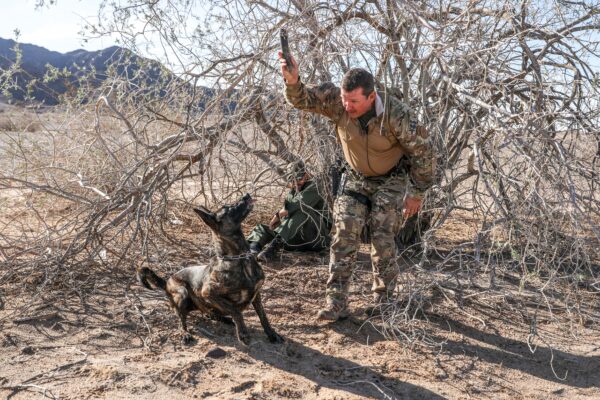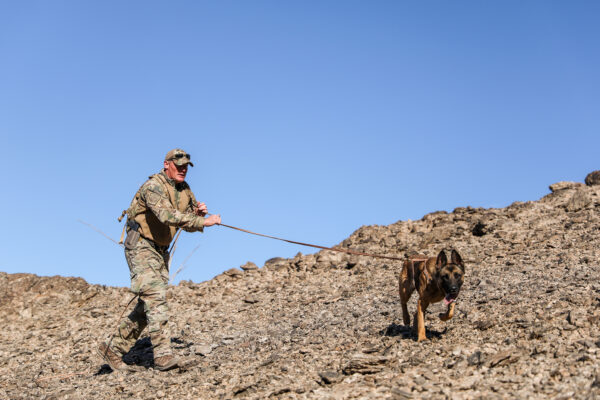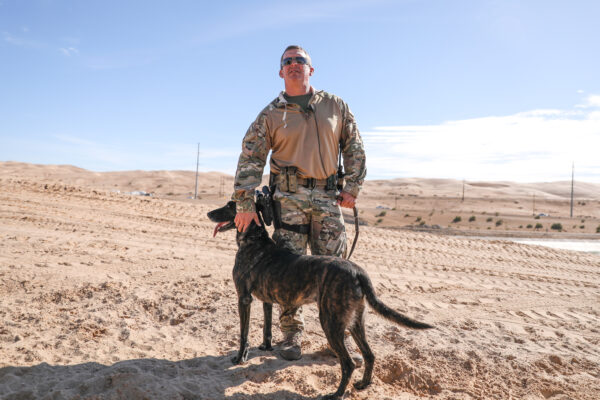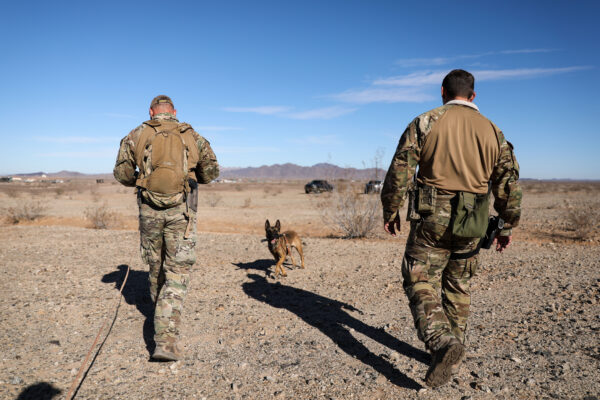BY
YUMA, Ariz.—Chad Smith kicks the dirt, seeking to discern the wind’s direction. To the untrained eye, it’s imperceptible on this still, dry day in the desert.
But Smith immediately gets it and positions himself downwind.
Kyra, his K-9 partner, is excited. She’s leaping around Smith, being goofy—she knows it’s time to work, and for her, that means fun. Smith tells her to sit, removes her collar, and gives the command to search.
Immediately, she’s fully engaged. Finding humans is her forte.
It’s an air-scent training exercise, so Smith walks in a zig-zag pattern, 75 feet one way, then 75 feet the other, slowly in the direction of where he asked a Border Patrol agent to hide, 150 feet away. At some point, Kyra will lock on to the human odor and follow it.
“In a strong wind, she has air-scented a quarter-mile away,” Smith said.
He kicks the dirt every 30 seconds or so to check if the subtle breeze has changed direction. It has, so he swings further south.
Kyra, unleashed, is loosely following Smith’s direction, but she knows what to do and she covers more ground faster than he does.
On the third zig-zag, Kyra’s head shoots up and Smith knows she’s zeroed in on the scent. She makes a beeline to the tangled, bare-branched shrub where the agent is tucked in. As soon as she discovers him, she dashes straight back to Smith, to “tell” him.
They both run back to the hidden agent, and she gets her prize—her toy and some play time with Smith.
“Goooood girl, good dog, goooood girl,” Smith says in his best falsetto. She chomps on her toy, a piece of fire hose, and bounds back and forth excitedly, while Smith pets her whenever she’s in range.
“When they find something, you’re yelling and you’re screaming, and it’s real high, happy praise. And that’s why we kind of look foolish once we give a dog a reward,” Smith said. “But the goal is to make the dog feel excited and want to do that kind of work. It’s important to keep the dog having fun.”

Border Special Ops
Smith is a Border Patrol BORSTAR supervisory agent based in Yuma, Arizona.
The 15-man Border Patrol Search, Trauma, and Rescue (BORSTAR) unit is half of the special operations division of Border Patrol. The other half is the tactical unit, BORTAC.
“A lot of what we do is very, very paramilitary,” Smith said. The special operations headquarters is located on the Fort Bliss military base near El Paso, Texas, and the unit operates more like a military squad than the Border Patrol agents patrolling the line.
The bulk of BORSTAR’s work involves operations to target transnational criminal organizations and cross-border criminal activity, and they work in high-risk areas.
“We’ll try to do three weeks of operations and one week of training, every month,” Smith said.
Smith is one of three K-9 handlers that BORSTAR uses to track illegal aliens and drug smugglers in the remote Arizona desert. He has also been called to find local Alzheimer’s patients who have wandered off and the bodies of murder victims, as well as to narrow the search area for drowning victims.
BORSTAR agents are jacks of all trades. They’re adept in tactical medicine, rope rescue, swift-water rescue, police diving, and land navigation. All of the men are EMT-certified, and five are paramedics.
Kyra, a Dutch shepherd, is an experienced tracking dog. She’s been with Smith since 2015, when his first dog retired. She uses her super snout to air-scent and ground track. She is also trained to find human remains.
Ground tracking involves a different technique to air-scenting, and Smith ritualizes the beginning of each type to get Kyra’s head in the game.
“Because that gets that dog thinking, ‘OK, this is work time. In the truck, I’m a dog. I’m sleeping, panting, farting, whatever, but as soon as I put that harness on, I’m going to work,’” Smith said.
First, he puts her in the harness—which is easier said than done. When Kyra sees the harness, she’ll start nudging it, trying to dress herself.
“Which makes it a pain to put on, but she thinks she’s helping me,” Smith said, laughing. “Dogs are amazing, that’s for sure. But sometimes they can be knuckleheads, too. It takes patience.”
Once she’s in the harness, Smith continues the ritual by laying the long leash down, walking away several feet, and walking back around the dog before attaching the leash and stretching it out.
The start of a track often involves some foot sign as to which direction the target is heading—it could be a footprint, a toe dig, or some broken brush. Smith places Kyra in front of the sign, removes the short leash, and gives her the command to search.

While her job is to keep her nose to the ground and follow every footprint, the rocky terrain doesn’t make it easy and footprints can be hard to come by.
“Sometimes they’re on carpet, sometimes they’re barefoot, sometimes they’re in shoes,” Smith said of the illegal aliens. Many times, the aliens—especially the drug smugglers—will wear shoe covers made of carpet to hide their tracks.
“I’ve done dozens and dozens of five- to eight-mile tracks,” Smith said. “Usually with those, there’s more people [illegal aliens], which makes it easier. The group leaves more ground disturbance, more odor.
“And when they’re dopers, it’s even easier, because of the odor from the weed, the burlap bags that they’re carrying, that’s sloughing on their backs, and the straps and the sweat—all that’s encompassed in the scent picture.”
The ultimate goal is for a K-9 to track people who have a 24-hour lead. “There’s no odor left after 24 hours,” Smith said.
“I get asked: ‘Why don’t you guys use bloodhounds?’” he said. “That [type of] dog would cry if he had to track in the areas that we track. When you watch TV shows with these goofballs and their bloodhounds, it’s not realistic. It’s ridiculous.”
The 13-Miler
Smith takes pride in recounting the story of his last dog, Gilley, who tracked an illegal alien for 13 miles through the arid mountains.
“That’s extremely hard for a dog to do in that terrain … climbing up and over mountain passes and rocks,” he said.
It took the whole day, but as long as he had water and Gilley was prepared to keep working, he wasn’t going to stop.
“That’s a long time to keep a dog engaged in something like that,” he said. He’d stop a couple of times per mile for about 10 minutes to give her a break.
There were times when Smith didn’t see any signs of human tracks and had to put complete trust in the dog’s ability.
“You might go a few hundred meters, and then all of a sudden, you see a print or a toe dig or something. Then you can give the dog some good praise. You know she’s in odor,” he said.
“Basically, she dictates the track. Because there’s been plenty of tracks where she looks at me and she’s like, ‘I’m done.’ … I mean, you can tell by the way she looks. At no point, would I ever let any of my dogs go to where they would just collapse. You have to go by how they feel.”
Brian White, a Border Patrol agent and the EMT coordinator for the area, has known Smith for more than 10 years.
“Let me tell you about Chad,” he said.
“Here’s the analogy. Let’s say you and me are in this truck and a Ferrari pulls up next to us and we’re going to race. Who’s going to win? What if I told you I’m driving this truck and my grandmother is driving the Ferrari? Now, who wins? We win, because of the driver, right? Because I’m willing to do more and I can drive my truck better than my grandmother could probably drive that Ferrari.
“So it’s the same way with those dogs. That handler, which is Chad Smith, who’s really good, makes the dog really good.”
White says Smith’s tenacity fits well in this job.
“He will not quit unless there’s serious injury to the dog or himself or somebody else,” White said. “That’s a real good quality to have when you’re doing search and rescue, and working in these environments.
“And even then, if the dog gets burned, then we just put the dog away [in a vehicle] and then we just keep pushing it on foot. We’ll keep going until we run out of water or we catch them.”
Getting Lost
On Nov. 27, a 911 call came over the Border Patrol radio: A man named Felipe was lost in the mountains. He’d separated from two others a couple of hours previously.
Smith said Felipe likely crossed the U.S.–Mexico border illegally, then hiked about 50 to 60 miles over two mountain ranges to get where he was.
“He’s smoked, he’s had enough,” Smith guessed—it’s not uncommon for illegal aliens to call 911 when they’re lost, injured, or simply worn out. The average daily temperature sits above 100 from June through September. But it was likely the torrential rain the night before that sped up Felipe’s decision to call 911.
The dispatcher called out the location coordinates—with the Yuma County Sheriff’s Office’s upgraded 911 call system, law enforcement can now pinpoint the location of a caller to within a few feet.
Several of the BORSTAR agents peeled off to go find him, including Mike Bailey and his Belgian Malinois, Zita. Access was going to be difficult after the rain, so they took a Polaris RZR—an all-terrain vehicle with meaty tires and leggy suspension.
“If they can take [Felipe] back to where the others left him, the dog might be able to get a lead on them,” Smith said.
Several hours later, they scooped up a worn Felipe and backtracked to where he’d separated from the other aliens.
Bailey put Zita on their track, which was by then about three hours old. “She was on it. I had the right wind. When the dog gets into the right scent cone, it’s fun watching them work it out,” he recalled the next day.
About a mile in, another 911 call came in, this time from the other two aliens; they had made it to the Devil’s Hills and got cell service. The dispatcher sent out the coordinates.
Zita was four miles out at the time and still on the scent, but it was more expedient to send in the RZR to pick them up.
“We would have found them. It just would have taken a lot more work, a lot more energy,” Bailey said. He just got Zita in April, and she’s young and learning fast.
Smith said that whenever possible, they’ll drive the dog up close to the aliens and then let her “find” them before getting her toy, “so the dog doesn’t work a bunch just to get pulled off and get nothing out of it.”

Bailey said the new technology connected to the 911 system is a game-changer.
“Ten years ago, that stuff didn’t exist—you couldn’t just get the coordinates,” he said. “We’d be out there for days, with paper maps laid out on the hood of the car. A search like that was a two- or three-day evolution. Now, with technology and everyone with cell service, it helps. … That 911 phone call service has probably saved more people than anything, or than any other agency could have done.”
Felipe and his friends, all Mexicans, were taken to the Wellton Border Patrol station for processing.
Helping Local Law Enforcement
Smith said that, although interdicting illegal aliens drives the bulk of their work, the K-9s get called on by local agencies, too.
“The southern border … is filled with a lot of tiny, tiny little law enforcement agencies,” he said. “They don’t have the funds to be able to have full-time dogs or divers or medics or things like that. So we get a lot of calls to help those other agencies out.”
BORSTAR is often called to locate the bodies of drowning victims. The K-9s help to narrow the search area, while the divers search and recover the bodies.
“Kyra’s not getting a reward until we pull that body out of the water,” Smith said.
Last April, Ryan Harmon, a sergeant at the Calipatria State Prison, died after a boat collision on Ferguson Lake, 30 miles north of Yuma and just inside the California state line.
Four days after the accident, Smith and Kyra went to the lake.
“If Kyra’s looking for somebody that’s under the water, all I can do is read her alert,” Smith said. He then tells the divers where to search.
Water currents and the wind can both make it complicated for a K-9 to discern a location.
Kyra was nonetheless able to narrow the search area and “our divers found [Harmon]. We were able to bring him back up,” Smith said. “That was a good one. She did something that very few dogs can do. All of our training had paid off.”

Murder Cases
While finding bodies can help provide closure to families, Smith and his K-9s have also helped catch a murderer.
“We were called out for a murder at Scottsdale Auto Collision up in Phoenix,” he said. “And [Gilley] was able to identify a trailer that had transported the murdered individual. We were able to testify and they found this guy guilty on second-degree murder. So, that was pretty amazing.”
Chad Norris, the owner of the box trailer that Gilley identified, was found guilty of murdering his business partner Jason Johnson in 2012. In July 2015, Norris was sentenced to 18 years in prison. Johnson’s body hasn’t been found.
Closer to home, Smith has been working a cold murder case in Yuma for the past six years.
“Her name’s Emily Heiber. And they caught the guy that murdered her, but he won’t confess as to where he did it,” he said. Heiber, 19, went missing in February 2013.
If local law enforcement gets a new lead on a possible location, Smith and his K-9 will go search.
“Families will call in mediums, and they’ll say that Emily’s in a certain spot, and they’ll call me, ‘Hey, would you mind going and searching the area?’
“I’ll go and search it,” he said.
“The family just wants closure. So I go and search it just for the family’s sake. I’m sure that’s miserable, not knowing where she is.”
When looking for human remains, Smith conducts an area search with the K-9, and depending how big of an expanse it is, he may section it off. Then, he’ll start downwind and begin presenting the ground to the dog “to keep its nose to the ground.” They’ll stick together and painstakingly cover the section in a cross-hatch pattern to ensure they cover as much ground as possible.
Whenever the dog alerts, he’ll mark it and come back to search the area more thoroughly.
“You can probe the area. If it’s been a long period of time, you can go through, say the day before, and start probing with a rod into that area, let that area off-gas a little bit that you’ve walked all over and created all that contamination, then come back in and bring the dog in,” he said.
Several years ago, he spent a week searching near “Hank’s Highway,” a dirt road in the desert just to the northeast of Yuma. A medium had identified the location.
“I would get up at three, four in the morning to beat the heat to get out there. And I started probing, searching, probing. Nothing.”
But, he said, with large areas like that, it’s hard to definitively say you’ve cleared them, because there’s no way to search the whole area.
“We haven’t come up with her yet,” he said. “If we were to be able to find Emily Hieber and actually bring some closure to her family, that would be awesome. That’s a tough one. That really is.
“And the problem that you have now, as time goes on, there’s nothing left. The only thing that’s left at this point is bone. And that leaves such little odor that it’s difficult to locate.”

Training
Aside from a yearly certification test, Smith is required to conduct weekly trainings with Kyra—one week is tracking and the next week is human remains.
The human-remains training is a combination of air-scenting and nose-to-the-ground tracking.
The training is always set up to be successful for the dog and are designed to fix any issues encountered in the field.
“The dogs are super-smart, super-super-smart. If you do something enough times, they’ll figure it out,” Smith said. But repetition can also lead to issues. For example, if a K-9 always finds aliens hiding in bushes, it could learn to go off its tracks to hunt bushes.
If something like that happens with Kyra, Smith will use the training time to refocus her. For example, they’ll train in an open field and hide someone in a natural depression. Or if the dog starts getting too visual, by following visible foot signs, instead of odors, he’ll train her at night.
“It forces the dog to use their nose,” he said. Then, when they’re following a track that has had more people walking through, the dog won’t be confused by criss-crossing footprints and can stay on the target odor.
BORTAC Dogs
The partner unit, BORTAC, also uses K-9s, but they’re trained differently to match their job description, Smith said.
“They’re patrol dogs, so they’re basically a bite dog,” he said. They can only be used on people who have committed felonies.
“They’ll use them typically if they’re serving a warrant, they know somebody’s in the house and they won’t come out.”
The handler will give the person a warning that the dog is coming in if they don’t come out.
“They don’t come out. Dog goes in. They may be hiding somewhere and the dog will air-scent them and then get a hold of them, and it’s a bad day for them,” Smith said.
“For a patrol dog, that bite is their reward. That person has just become a toy. And a lot of times, the dog doesn’t want to give it up. They won it, it’s theirs.”
Once the handler gives the command, the dog should release, he said.
“So, where we have a lot of obedience with our dogs, they have to have it even better. They have to be able to control their dogs all the time,” Smith said.
Retirement
Each dog is different and is directed into a certain line of work, based on its innate characteristics and drives. The age for retirement also depends on the dog.
Smith said Gilley started not wanting to leave his side. That was an indication to him that she was ready for retirement.
She’s now Smith’s pet.
“She loves being retired. She’s a lab,” he said.
Kyra, on the other hand, probably won’t want to retire, he said.
Working is what drives her, and Smith predicts she’s got several more years of tracking in the desert mountains ahead of her.
“She’s a really athletic dog. Usually, the weak link in the team is me.”
Republished with Permission The Epoch Times SUBSCRIBE
Get Citizensjournal.us Headlines free SUBSCRIPTION. Keep us publishing – DONATE




